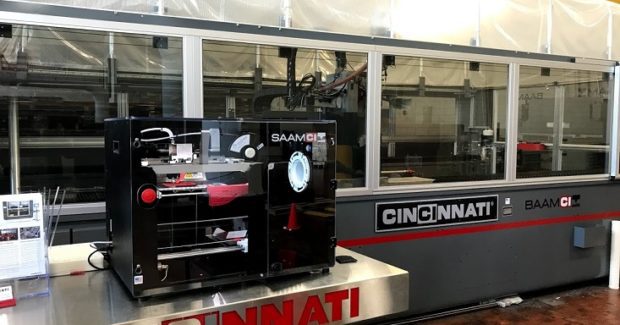How to Prove-Out Large Aerospace Part Form and Functionality Before Building
Powered by NVBOTS, the SAAM system from Cincinnati Incorporated uses fused filament fabrication technology to 3D print plastic parts directly from a CAD design so that designers can prove-out part form and functionality while saving material and time prior to building out full-scale parts on a BAAM.
Posted: May 25, 2018
Cincinnati Incorporated (CI; Harrison, OH) offers their SAAM (Small Area Additive Manufacturing) system that is powered by NVBOTS and uses fused filament fabrication (FFF) technology to 3D print plastic parts directly from a CAD design. The system allows designers to prove-out part designs while saving material and time. Once the design has been validated for form and functionality using SAAM, the same files can then be used to produce full-scale parts on a BAAM (Small Area Additive Manufacturing) large-scale additive system or other metal fabrication equipment. BAAM can build large components layer-by-layer – including those used in aerospace, automotive, marine, appliance and other applications – by extruding a wide variety of thermoplastics and fiber-reinforced thermoplastics. BAAM is built on a fabricated frame and uses patented CI advanced linear drive motors. SAAM uses the same process to produce prototypes and smaller parts, saving materials and providing a right-sized solution for additive applications.
SAAM also simulates parts produced by non-additive machines, and the same CAD file used for the prototype can be sent to a laser or press brake for metal fabrication. It dramatically reduces waste in the design process and accelerates advancement to production phase. “The SAAM system is proving to be the perfect complement to BAAM,” said Matt Garbarino, the director of marketing communications for CI, which also released CIberDash, an Industry 4.0 system that allows users to monitor production data from CI lasers, press brakes, or shears, in real-time. The data is resident in the machine’s control and is connected to the utility via network. The network connection between the machine and CIberDash is through an Ethernet connection or a cellular transmitter from CI called CIberLink. The dashboard is configured to display information desired by the user, as well as the status of the production of each CI machine. The utility includes a StackLight graphic to quickly convey machine status via a familiar graphic.
Cincinnati Incorporated, 7420 Kilby Road, Harrison, OH 45030, 513-367-7100, info@e-ci.com, www.e-ci.com.




